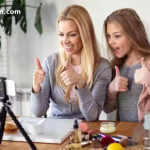Recent high-profile documentaries such as Devil in the Family: The Fall of Ruby Franke on Hulu and Netflix’s Bad Influence: The Dark Side of Kidfluencing are casting a much-needed spotlight on a critical issue: the dark underbelly of family vlogging exploitation. These eye-opening productions pull back the curtain on how children in popular YouTube and Instagram channels are being exposed to potential child labor violations, privacy invasions, and long-term psychological harm—all under the guise of wholesome, family-friendly content.
How Family Vlogging Puts Children at Risk
Platforms like YouTube and Instagram have become lucrative stages for “momagers” and content-driven parents, often at the expense of their kids. In Bad Influence, two child advocacy activists call out the dangerous practices behind Piper Rockelle’s wildly popular channel, particularly focusing on her mother and manager, Tiffany Smith.
While YouTube dominates in terms of reach—with over 20 billion uploaded videos and the largest share of TV viewership—it’s Instagram that experts like Chris McCarty and Sarah Adams deem even more troubling. The platform’s monetization features allow for paywalled content, increasing the risk of online child exploitation.
McCarty, founder of Quit Clicking Kids, raised alarms about exclusive content featuring minors being placed behind paywalls. Though Instagram began limiting such monetization in 2024, with “Teen Accounts” automatically enforced for users under 18, enforcement remains inconsistent.
The Push for New Child Influencer Laws
Fueled by public outcry and first-hand activism, a wave of child influencer laws is now gaining momentum across the U.S. McCarty, a University of Washington student, drafted and lobbied for legislation after learning about the infamous case of Myka and James Stauffer, who rehomed their adopted child after using his story to grow their YouTube audience.
Her advocacy helped spark legislative action. Illinois passed SB 1782 with bipartisan support, followed by California’s SB764—especially significant due to the state’s influence over digital media and entertainment. These bills are inspired by California’s Coogan Law and require that a portion of the income earned from child influencers be set aside in trust. They also give those children the right to delete content once they reach adulthood.
Why Sharenting Needs Regulation Now
The term sharenting—a blend of “sharing” and “parenting”—has become shorthand for the problematic behavior of oversharing children’s lives for online clout or profit. While McCarty focuses on sharenting regulation, Adams, founder of Kids Are Not Content, seeks to change the culture around child content entirely. She warns that young kids performing for millions of viewers are constantly “in performance mode,” which may impact their mental health and development.
Adams emphasizes the limitations of current protections. Unlike professional film sets, where minors have restricted work hours and on-set teachers, family vlogs often take place in private homes. This lack of oversight makes it nearly impossible to enforce labor protections, especially when content creators argue their kids are simply “living their lives.”
Yet, as Adams points out, “Trust me, these kids are acting. They know when the camera is on.” The blurred lines between genuine family moments and orchestrated performances blur the moral boundaries of YouTube child labor.
Social Media Platforms Respond, But Is It Enough?
In response to mounting pressure, companies like Meta (Instagram’s parent) and YouTube have taken steps to curb social media child safety issues. Instagram now restricts monetization for accounts that predominantly feature children, and YouTube has terminated and demonetized several problematic channels—including those linked to Ruby Franke.
YouTube says it voluntarily allows children featured in content to request takedowns once they turn 18, aligning with McCarty’s proposed laws. Still, the platforms’ efforts are often reactive rather than preventative.
Where Do We Go From Here?
Parents who casually post family moments online need not panic: the proposed laws only apply to monetized accounts that feature children in 30% or more of videos and generate at least $0.10 per view. However, as family vlogging exploitation becomes harder to ignore, both lawmakers and the public are recognizing the urgent need for reform.
Changing the law is one step, but changing minds is just as vital. “If I can help parents look through a different lens at this—in the way they share their kids, in the way they consume content online—then that’s what I can offer,” says Adams.
As child influencer laws continue to evolve, the conversation about sharenting regulation and child safety on social media is more critical than ever.












